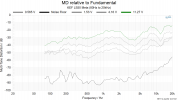LeonidKogan
Member
- Joined
- Apr 6, 2024
- Messages
- 33
- Likes
- 11
Has anyone compared them with KH120/8030c?
Answer A: try it and let us knowI wonder if using high pass filter on those really makes a significant difference in clarity vs simply aligning the sub below LS50M extension?
Here's the LS50M's multitone distortion full-range vs high-passed at 80Hz:I wonder if using high pass filter on those really makes a significant difference in clarity vs simply aligning the sub below LS50M extension?


80 Hz is probably pretty low for this speaker - my crossover is at 140hzHere's the LS50M's multitone distortion full-range vs high-passed at 80Hz:
View attachment 374476 View attachment 374477
Source: https://www.erinsaudiocorner.com/loudspeakers/kef_ls50_meta/
You can flip between them using the arrow keys to compare.
IMO, there's no significant improvement.
my sub only goes to 120hz.tlooo80 Hz is probably pretty low for this speaker - my crossover is at 140hz
I've never ever seen my LS50's cones moving, I don't listen to electronic music with sub frequencies and also the only time I might go over 85dB peak is during orchestral culminations. That is still not enough to visibly move a cone. Probably it doesn't have any effect on directivity. I can't imagine how uncomfortably loud Amir must have pushed his speaker to separate the cone from the tweeter. Is that 'boxiness' I'm hearing on higher volumes an effect of distortion or something else? That I don't know.Answer A: try it and let us know
Answer B: LS50 has a small cone, so attempting to output any significant bass means a lot of excursion. That cone acts as a waveguide on the tweeter, therefore excursion modulates the treble response. A highpass filter would reduce that. How audible a difference? Try it and let us know
2.0 or 2.1 setup?Btw. Is there a way to add high-pass filter to the system while still keeping RME ADI-2 as a dac?
2.1, regular ADI-2 DAC FS.2.0 or 2.1 setup?
ADI-2 DAC or ADI-2 Pro?
The only option then is an analog HPF between the ADI-2 and your Power Amp.2.1, regular ADI-2 DAC FS
I wonder if using high pass filter on those really makes a significant difference in clarity vs simply aligning the sub below LS50M extension? I've always loved those speakers, their imaging, accuracy, timbre etc., but since I bought Kali IN8 v2 I've had hard time justifying keeping LS50M. At higher SPL and full-range excerpts (Mahler's 2nd finale) they just sound compressed and muddy, while Kalis are much more effortless and clear. I have a small subwoofer but even with it they still don't sound as 'grand' as the Kalis. I only have RME ADI-2 so for now there is no way to use HPF on the KEFs. Will it make it as competent 3-way speaker as the Kalis?
Here's the LS50M's multitone distortion full-range vs high-passed at 80Hz:
View attachment 374476 View attachment 374477
Source: https://www.erinsaudiocorner.com/loudspeakers/kef_ls50_meta/
You can flip between them using the arrow keys to compare.
IMO, there's no significant improvement.
I think it would be more productive for you to just post the frequency response of each setup. This would make it far easier to than attempting to decipher your personal adjectives.
At your listening volume chances are both setups could be set up & EQ'd to sound very similar.
I'd ditch the RME and replace with a MiniDSP so you can properly integrate the sub. Once you have the capability to fine tune alignment its an eye opener just how much it effects frequency response.
A steady-state multitone signal is played on the speakers.How is this test run? Is it a sweep? If yes, perhaps it is not measuring the distortion in question.
Is that this wardrobe?Green line is Kali eq'd to flat target without sub, orange line is LS50M+REL T/Zero. The 100Hz dip seen on the Kalis is a room mode (I just realized yesterday it improves significantly when I open the door of my big cloth wardrobe on the left LMAO),
It is a large reflecting surface next to the left speaker that changes the way waves bounce when open, and it being full of soft clothes probably provides some dampening and the measurements show the differenceIs that this wardrobe?
https://www.goodreads.com/book/show/100915.The_Lion_the_Witch_and_the_Wardrobe
Or this one?
how does this combination go? Do you find it lacking or is it just right for the room size?? Does the centre speaker provide enough clarity for dialogue etc? What sort of films do you watch often through this set up?In a 12 X 12 space, I have a 5.2 with the Metas as L-R, Kef HTC 3001 SE as center, OG LS 50s as SL-SR, and two SVS SB 2000's for subs. I have Dirac Live and get everything over streaming services and files I ripped from my old Blue Ray, DVD, and CD collections. And yes, IMHO the Metas are a big improvement over the already very good originals, but if you own the originals, I wouldn't throw them out. Just do what I did, and use them for the surrounds.
